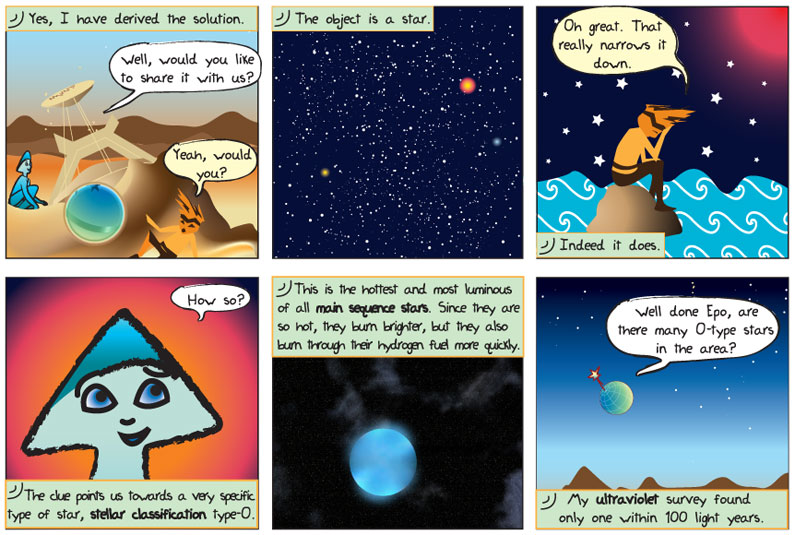
Transcript:
Panel 1
Epo: Yes, I have derived the solution.
Alkina: Well, would you like to share it with us?
Beggrin: Yeah, would you?
Panel 2
Epo: The object is a star.
Panel 3
Beggrin: Oh, great. That really narrows it down.
Epo: Indeed it does.
Panel 4
Alkina: How so?
Epo: The clue points us towards a very specific type of star, stellar classification type-O.
Panel 5
Epo: This is the hottest and most luminous of all main sequence stars. Since they are so hot, they burn brighter, but they also burn through their hydrogen fuel more quickly.
Panel 6
Alkina: Well done, Epo, are there many O-type stars in the area?
Epo: My ultraviolet survey found only one with one hundred light years.
What does it mean?
Stellar Classification – This is a system in which stars are given a classification of O, B, A, F, G, A, K, or M based on their surface temperature, with O being the hottest and M being the coolest. Our Sun is a type G, with a surface temperature of about 6000K. Officially, this is known as the Morgan-Keenan spectral classification system.
Main sequence star – are the ones that are actively fusing hydrogen into helium in their cores. Their inward gravitational force due to the mass of the star is balanced by the outward thermal pressure generated by nuclear fusion.
In human speak please!
There are many different kinds of stars. In order to keep track of them all, scientists have created various systems to categorize them. The most commonly used stellar classification system organizes stars by their surface temperature. For main sequence stars this is closely related to their mass. O-type stars are the hottest of all main sequence stars, with surface temperatures in excess of 30,000 K (53,500 F). O stars are also the largest and rarest types of main sequence stars. While they are very bright in the visual part of the spectrum, they are even brighter in the ultraviolet, where their spectra peak. Of course, since they burn through their hydrogen so quickly they live for only a short time compared to lower mass stars. Typical main sequence life spans of O-Type stars are only a few million years. Compare that to the Sun, which has a main sequence lifetime of 10 billion years.
